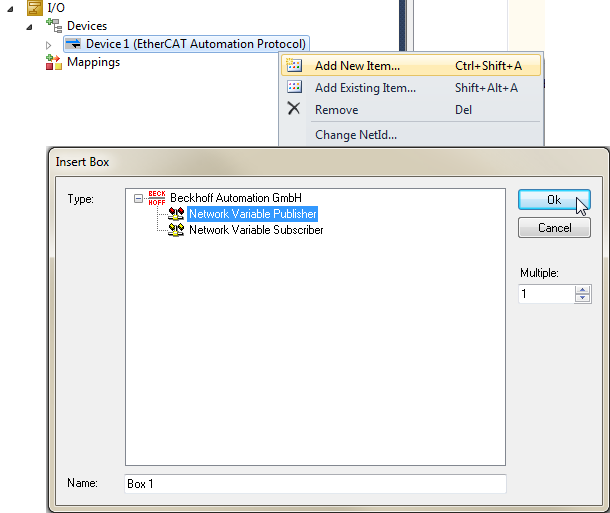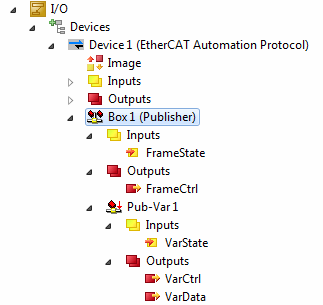Addition of publisher variables
If the EAP device is to send variables, Publisher Variables must be added in order to complete its configuration (see following illustration).
- 1. In the context menu of the EAP device node (Device 1), click on the entry [Add New Item...].
- The Insert Box dialog opens.
- 2. Select the Network Variable Publisher and click on [OK].
 | Addition of several publishers If several Publishers are to be created, the number can be set using the Multiple input field. |

The Publisher Variables (TxData) are subsequently appended to the created Publisher (see following illustration).
- 1. In the context menu of the Publisher, click on the menu item [Add new Item...].
- The dialog Insert Network Variable appears.
- 2. Select a data type for the Publisher Variable, enter a designation in Name, define an ID and then click on [OK].
- The node for this Publisher Variable appears under the Publisher (see next illustration).
 | Assignment of an ID The selected ID for a Publisher Variable should be unique in the network. |

In the course of the configuration of publisher variables, input and output variables are generated that belong to the various nodes and sub-nodes of the EAP device (see following illustration). In addition to the unconditional input/output variables there are also conditional ones that are only generated if certain configuration settings are made.

All of the input/output variables together ultimately form the process image of the EAP device. If they are linked with the variables of an application (e.g. a PLC program) in TwinCAT, then the latter can read these contents from the process image or write values into the process image. The purpose of the output variables is to write values that, for example, control the behavior of the EAP device. The purpose of input variables is to read their values in order, for example, to evaluate status information in the PLC program and to react to it. In this way the behavior of the EAP device can be directly influenced from a PLC.
 | Appearance of the input and output variables The structure of the process image varies, depending on which port (network adapter of the PLC or an EL66xx Switch Port Terminal) the EAP device uses for communication. |
Description of the unconditional input/output variables
FrameState
The FrameState input variable below the Publisher node indicates the current state of the TxFrame. A detailed description can be found in the Publisher section.
FrameCtrl
The FrameCtrl output variable below the Publisher can be used to control the transmission of the EAP telegram. The following values are possible for FrameCtrl:
|
Short description |
Bit |
Description |
|---|---|---|
|
Disable sending |
FC.0 |
The transmission of the frame is interrupted if the bit is set to 1. The transmission of the frame only restarts when the value falls back to 0. |
|
Remove destination MAC from ARP cache |
FC.1 |
This control box only has an effect if the EAP telegram is sent by IP or AMSNetID. The destination MAC address entered in the ARP cache is deleted if the bit is set. A new entry can only be made when the bit is reset to 0, provided the EAP device can determine the destination MAC address by ARP. (see also Remote station monitoring via ARP) |
 | Appearance of the output variable FrameCtrl This variable does not exist in the case of EAP communication via the EL66xx terminal! Instead, the output variable CycleIdx (size: 16 bits) is created, which is to be used for a diagnosis of the communication connection (see Diagnosis of an EAP connection). |
VarState
The input variable VarState below the Publisher Variable indicates the current state of TxData. A detailed description can be found in the Publisher section.
VarCtrl
The output variable VarCtrl below the Publisher Variable can be used to control the transmission of the Publisher Variable. The following values are possible for VarCtrl:
|
Short description |
Bit |
Description |
|---|---|---|
|
Disable publishing |
VC.0 |
The transmission of the Publisher Variable is interrupted. The transmission of the Publisher Variable restarts only when the value of the bit has returned to 0. |
 | Appearance of the output variable VarCtrl This variable does not exist in the case of EAP communication via the EL66xx terminal! |
CycleIndex
The output variable CycleIndex below the TxProcessData should be linked with an application variable that is cyclically incremented, since the CycleIndex on the receiving side can be evaluated for diagnostic purposes (see Diagnosis of an EAP connection).
 | Appearance of the output variable CycleIndex The output variable CycleIndex only exists if the EAP communication takes place via the EL66xx terminal! |
VarData
The output variable VarData of the Publisher Variable can be linked with any desired variable of a suitable data type (e.g. with the variables of a PLC program).
Description of the conditional output variables
MAC / NetID / IP
The output variable MAC / NetID / IP below the Publisher Box node only exists if the option Target Address Online Changeable is activated. In this case the destination address of the EAP telegram can be changed dynamically (e.g. with the help of a PLC program).
Depending on the type of addressing configured for TxFrame (MAC Address, AMS NetID or IP), the data type of the variables is a MAC, a NetID or an IP.
VarId
The output variable VarId below the Publisher Variable only exists if the option Online Changeable is activated for the variable ID. In this case the ID for the TxData can be changed dynamically (e.g. with the help of a PLC program).